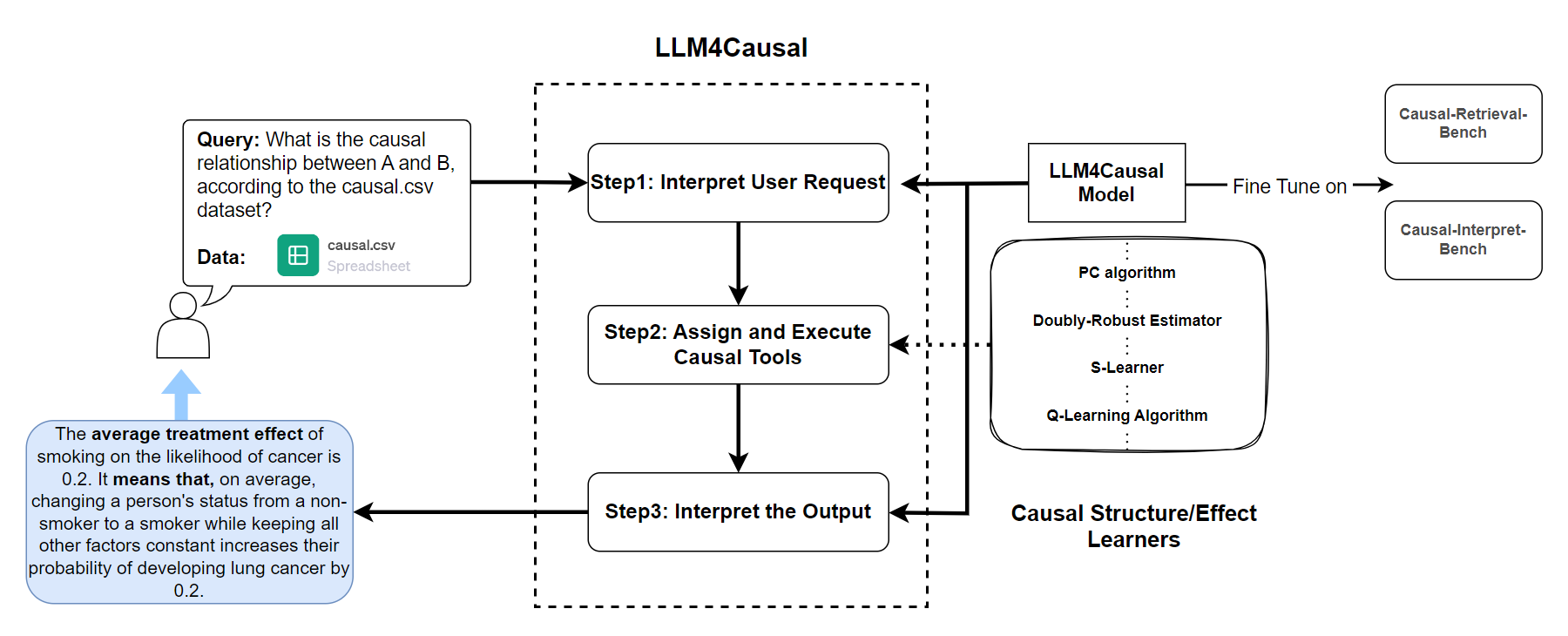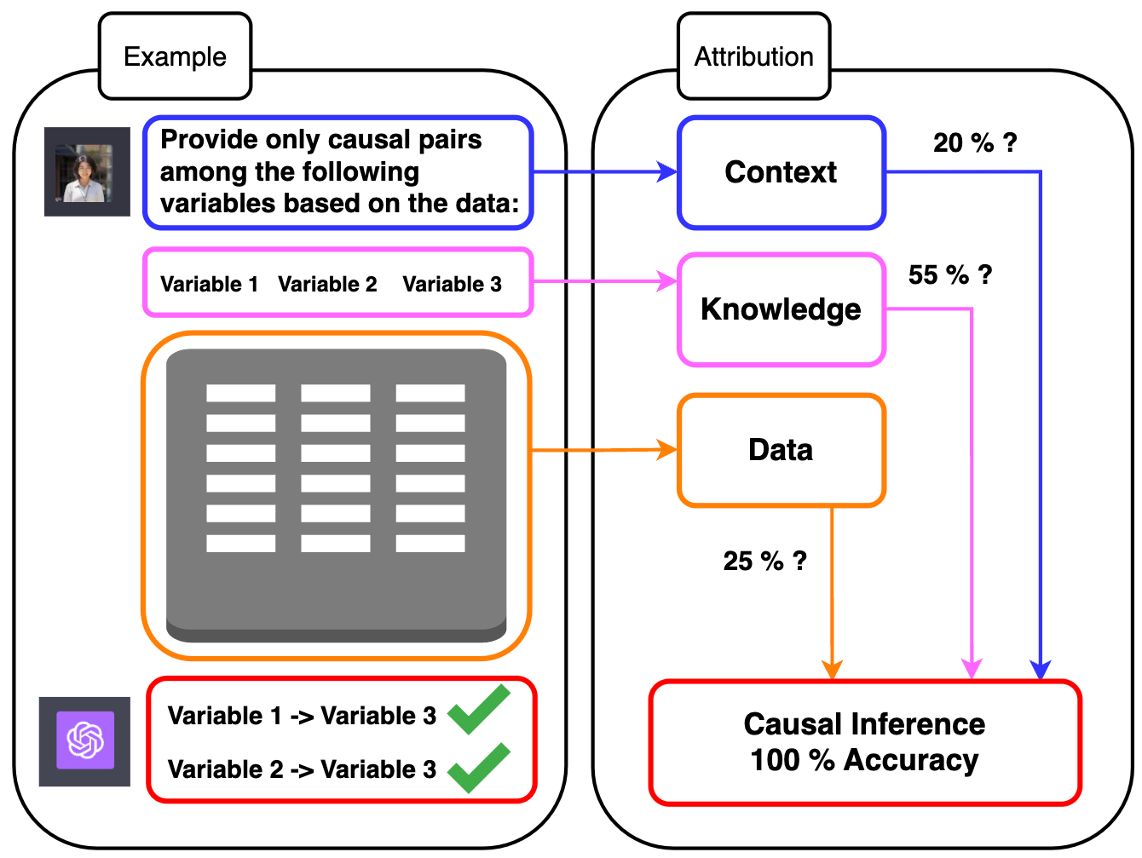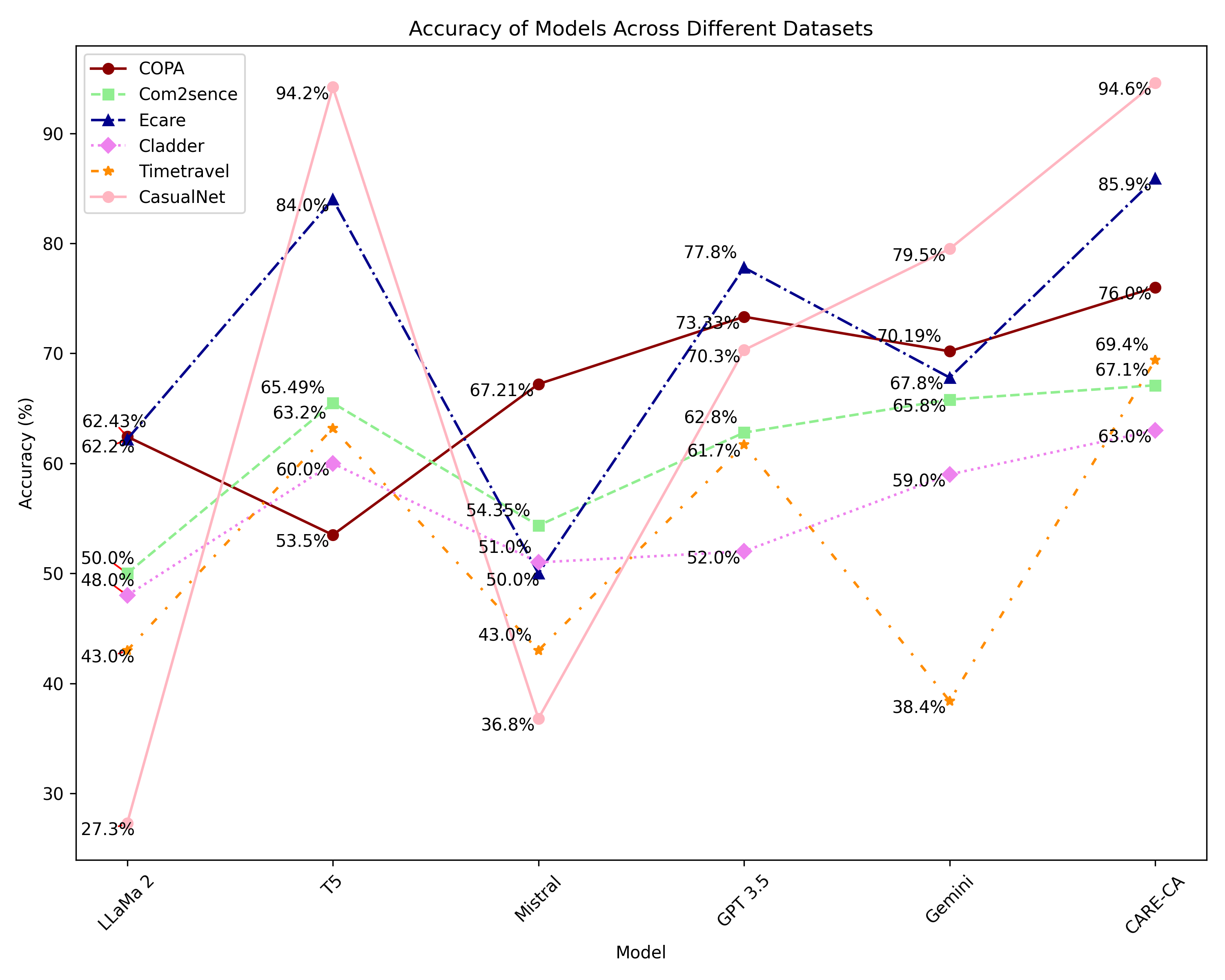Large Language Model for Causal Decision Making
2312.17122

0
0

Abstract
Large Language Models (LLMs) have shown their success in language understanding and reasoning on general topics. However, their capability to perform inference based on user-specified structured data and knowledge in corpus-rare concepts, such as causal decision-making is still limited. In this work, we explore the possibility of fine-tuning an open-sourced LLM into LLM4Causal, which can identify the causal task, execute a corresponding function, and interpret its numerical results based on users' queries and the provided dataset. Meanwhile, we propose a data generation process for more controllable GPT prompting and present two instruction-tuning datasets: (1) Causal-Retrieval-Bench for causal problem identification and input parameter extraction for causal function calling and (2) Causal-Interpret-Bench for in-context causal interpretation. By conducting end-to-end evaluations and two ablation studies, we showed that LLM4Causal can deliver end-to-end solutions for causal problems and provide easy-to-understand answers, which significantly outperforms the baselines.
Create account to get full access
Overview
- This paper explores the use of large language models (LLMs) for causal decision making, which involves understanding the cause-and-effect relationships between actions and outcomes.
- The researchers investigate the ability of LLMs to reason about counterfactuals, make interventions, and learn causal models from observational data.
- The paper presents experiments and findings that shed light on the current capabilities and limitations of LLMs in this domain, as well as potential future directions for research and development.
Plain English Explanation
Large language models (LLMs) are AI systems that can understand and generate human-like text. These models have shown impressive capabilities in a wide range of tasks, from answering questions to writing stories. However, their ability to reason about cause and effect, which is crucial for making informed decisions, has been less explored.
This paper looks at how well LLMs can handle causal decision making. Causal decision making involves understanding the relationships between actions and their consequences. For example, if you take a certain medicine, how will it affect your health? Or if you make a specific investment, what will the financial outcome be? LLMs need to be able to reason about these kinds of cause-and-effect relationships in order to be truly useful for decision making.
The researchers conducted experiments to test the causal reasoning capabilities of LLMs. They looked at how well the models could understand counterfactuals (what would happen if things were different), make interventions (change one factor to see the effect), and learn causal models from observational data (patterns in the real world). The results shed light on the current strengths and limitations of LLMs in this domain.
By understanding the capabilities and shortcomings of LLMs when it comes to causal reasoning, the researchers hope to inform future developments in this area. Improving the ability of LLMs to understand cause and effect could lead to better decision-making tools, more reliable AI systems, and a deeper understanding of human cognition.
Technical Explanation
The paper explores the causal reasoning capabilities of large language models (LLMs). The researchers conducted a series of experiments to assess how well LLMs can understand counterfactuals, make interventions, and learn causal models from observational data.
In the counterfactual reasoning task, the models were asked to answer questions about what would have happened if certain events had occurred differently. The researchers found that while LLMs could sometimes provide plausible counterfactual answers, their performance was inconsistent and often reflected biases in the training data.
The intervention task tested the models' ability to reason about the effects of changing a specific factor in a causal system. The results showed that LLMs struggled to accurately predict the outcomes of interventions, particularly when the causal relationships were more complex.
Finally, the researchers explored the models' capacity to learn causal models from observational data. They found that LLMs could extract some causal information from text, but their ability to construct accurate, generalizable causal models was limited.
The paper also discusses the potential of using structured knowledge bases to enhance the causal reasoning capabilities of LLMs. The authors suggest that combining LLMs with external causal knowledge could lead to more robust and reliable causal decision making.
Overall, the findings of this paper highlight the current limitations of LLMs in the domain of causal reasoning and decision making. While these models have shown impressive capabilities in many areas, the authors argue that further research and development is needed to unlock their full potential for causal understanding and decision support.
Critical Analysis
The paper provides a thorough and well-designed investigation into the causal reasoning capabilities of large language models (LLMs). The researchers have carefully constructed a series of experiments to test different aspects of causal reasoning, including counterfactual reasoning, intervention, and causal model learning.
However, the paper also acknowledges several limitations and caveats of the research. For example, the experiments were conducted on a limited set of LLM architectures and training datasets, and the causal scenarios used may not fully capture the complexity of real-world decision making. Additionally, the paper notes that the models' performance was often influenced by biases present in the training data, which is a common challenge in the development of AI systems.
One area that could be further explored is the potential of using structured knowledge bases to enhance the causal reasoning capabilities of LLMs. The paper briefly mentions this possibility, but more research is needed to understand how well this approach can address the limitations identified in the current experiments.
Another potential limitation is the reliance on text-based tasks and datasets. While this is a logical starting point, it raises questions about the generalizability of the findings to more diverse decision-making scenarios that may involve multimodal information, dynamic environments, and real-world interventions.
Overall, this paper makes a valuable contribution to the understanding of LLM capabilities in the domain of causal reasoning and decision making. The insights generated by this research can inform the development of more robust and reliable AI systems for causal decision support. However, further research is needed to address the limitations and explore more complex and realistic causal decision-making scenarios.
Conclusion
This paper presents a comprehensive evaluation of the causal reasoning capabilities of large language models (LLMs). The researchers conducted a series of experiments to assess how well LLMs can understand counterfactuals, make interventions, and learn causal models from observational data.
The findings indicate that while LLMs have made significant progress in natural language processing and generation, their ability to reason about cause and effect is still limited. The models struggled with accurately predicting the outcomes of interventions and constructing generalizable causal models from data.
The paper suggests that combining LLMs with structured knowledge bases and other techniques could help to enhance their causal reasoning capabilities. Improving the causal decision-making abilities of LLMs could lead to better decision-making tools, more reliable AI systems, and a deeper understanding of human cognition.
Overall, this research highlights the importance of continued development and evaluation of causal reasoning in large language models. As AI systems become more integrated into our decision-making processes, it is crucial that they demonstrate robust and reliable causal understanding to ensure safe and effective deployment.
This summary was produced with help from an AI and may contain inaccuracies - check out the links to read the original source documents!
Related Papers

Evaluating Interventional Reasoning Capabilities of Large Language Models
Tejas Kasetty, Divyat Mahajan, Gintare Karolina Dziugaite, Alexandre Drouin, Dhanya Sridhar

0
0
Numerous decision-making tasks require estimating causal effects under interventions on different parts of a system. As practitioners consider using large language models (LLMs) to automate decisions, studying their causal reasoning capabilities becomes crucial. A recent line of work evaluates LLMs ability to retrieve commonsense causal facts, but these evaluations do not sufficiently assess how LLMs reason about interventions. Motivated by the role that interventions play in causal inference, in this paper, we conduct empirical analyses to evaluate whether LLMs can accurately update their knowledge of a data-generating process in response to an intervention. We create benchmarks that span diverse causal graphs (e.g., confounding, mediation) and variable types, and enable a study of intervention-based reasoning. These benchmarks allow us to isolate the ability of LLMs to accurately predict changes resulting from their ability to memorize facts or find other shortcuts. Our analysis on four LLMs highlights that while GPT- 4 models show promising accuracy at predicting the intervention effects, they remain sensitive to distracting factors in the prompts.
4/9/2024

Is Knowledge All Large Language Models Needed for Causal Reasoning?
Hengrui Cai, Shengjie Liu, Rui Song

0
0
This paper explores the causal reasoning of large language models (LLMs) to enhance their interpretability and reliability in advancing artificial intelligence. Despite the proficiency of LLMs in a range of tasks, their potential for understanding causality requires further exploration. We propose a novel causal attribution model that utilizes ``do-operators for constructing counterfactual scenarios, allowing us to systematically quantify the influence of input numerical data and LLMs' pre-existing knowledge on their causal reasoning processes. Our newly developed experimental setup assesses LLMs' reliance on contextual information and inherent knowledge across various domains. Our evaluation reveals that LLMs' causal reasoning ability mainly depends on the context and domain-specific knowledge provided. In the absence of such knowledge, LLMs can still maintain a degree of causal reasoning using the available numerical data, albeit with limitations in the calculations. This motivates the proposed fine-tuned LLM for pairwise causal discovery, effectively leveraging both knowledge and numerical information.
6/6/2024

Large Language Models for Constrained-Based Causal Discovery
Kai-Hendrik Cohrs, Gherardo Varando, Emiliano Diaz, Vasileios Sitokonstantinou, Gustau Camps-Valls

0
0
Causality is essential for understanding complex systems, such as the economy, the brain, and the climate. Constructing causal graphs often relies on either data-driven or expert-driven approaches, both fraught with challenges. The former methods, like the celebrated PC algorithm, face issues with data requirements and assumptions of causal sufficiency, while the latter demand substantial time and domain knowledge. This work explores the capabilities of Large Language Models (LLMs) as an alternative to domain experts for causal graph generation. We frame conditional independence queries as prompts to LLMs and employ the PC algorithm with the answers. The performance of the LLM-based conditional independence oracle on systems with known causal graphs shows a high degree of variability. We improve the performance through a proposed statistical-inspired voting schema that allows some control over false-positive and false-negative rates. Inspecting the chain-of-thought argumentation, we find causal reasoning to justify its answer to a probabilistic query. We show evidence that knowledge-based CIT could eventually become a complementary tool for data-driven causal discovery.
6/12/2024

Cause and Effect: Can Large Language Models Truly Understand Causality?
Swagata Ashwani, Kshiteesh Hegde, Nishith Reddy Mannuru, Mayank Jindal, Dushyant Singh Sengar, Krishna Chaitanya Rao Kathala, Dishant Banga, Vinija Jain, Aman Chadha

0
0
With the rise of Large Language Models(LLMs), it has become crucial to understand their capabilities and limitations in deciphering and explaining the complex web of causal relationships that language entails. Current methods use either explicit or implicit causal reasoning, yet there is a strong need for a unified approach combining both to tackle a wide array of causal relationships more effectively. This research proposes a novel architecture called Context Aware Reasoning Enhancement with Counterfactual Analysis(CARE CA) framework to enhance causal reasoning and explainability. The proposed framework incorporates an explicit causal detection module with ConceptNet and counterfactual statements, as well as implicit causal detection through LLMs. Our framework goes one step further with a layer of counterfactual explanations to accentuate LLMs understanding of causality. The knowledge from ConceptNet enhances the performance of multiple causal reasoning tasks such as causal discovery, causal identification and counterfactual reasoning. The counterfactual sentences add explicit knowledge of the not caused by scenarios. By combining these powerful modules, our model aims to provide a deeper understanding of causal relationships, enabling enhanced interpretability. Evaluation of benchmark datasets shows improved performance across all metrics, such as accuracy, precision, recall, and F1 scores. We also introduce CausalNet, a new dataset accompanied by our code, to facilitate further research in this domain.
4/17/2024